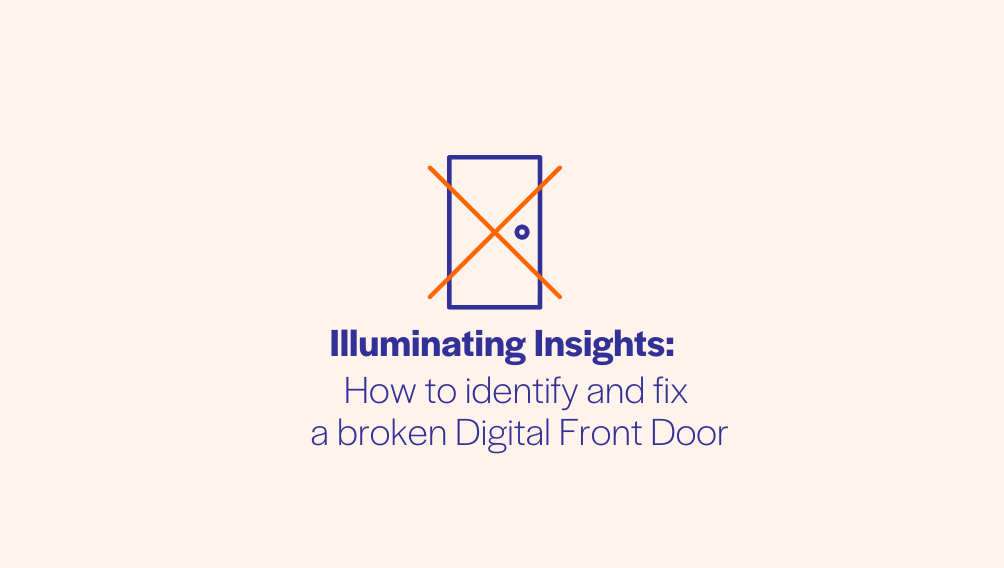How to identify and fix a broken Digital Front Door

Digital front door. Before 2020, this phrase was relatively obscure in the healthcare landscape, jumping to the collective forefront when the COVID-19 pandemic drove providers to adapt quickly to digital care options. Three years later, the digital front door is here to stay, promising to:
- Reduce administrative burden
- Increase mobile and/or portal engagement
- Reduce no-show-rate/more appointments filled
- Increase patient satisfaction/convenience
Digital front doors (DFDs) can be best defined as a digital platform with one or more of the following features: a portal, mobile app, provider directory, symptom checker, or patient scheduling.
When a DFD works well, it seamlessly connects your communication, outreach, scheduling, and patient information, working in the background while your team provides in-person care.
But what happens when a DFD strategy falls short? Luma’s team of product experts share how to analyze your DFD experience, identify the areas for improvement, and move forward towards greater patient success.
Step 1: How to Identify Broken Digital Front Doors
According to the United States Government Accountability Office, 90% of organizations reported offering a patient portal, but only about a third of patients use them. When you’re doing everything “right,” but still lack patient connection, it can be frustrating to troubleshoot yet another solution.
When a DFD is broken, you may experience:

The Trap Door: Trap doors bring patients in, then let them fall through the floor, resulting in patient frustration and need for additional, resource-consuming follow-up. Typically, the trap door is not a full platform experience. Instead, if this sounds like your organization, you might be using point solutions such as:
- Appointment request forms
- Chat-only bots
- Booking without screening/registration

The Side Door: Side doors occur when patients try to get in touch differently than the organization prefers, creating uncontrolled costs, overworked staff, and a fragmented patient experience. You might have a side door issue at your organization if you have:
- High volumes of phone calls
- Disconnected messaging tools
- Inappropriate patient self-triage

The Rusted Door: Rusted doors occur when getting through the digital front door is too difficult for patients, resulting in low adoption and the organizational belief that patients don’t want or need digital tools. If this sounds like your organization, you might have:
- Outdated patient portals
- Mobile-unfriendly UIs
- Complicated scheduling processes
Step 2: How to Mend your Broken DFD
Broken digital front doors create frustrating bottlenecks for patients and staff, resulting in lower adoption of digital tools and a reliance on human capital to smooth the gaps. With healthcare staff reporting higher levels of burnout and sky-rocketing operating costs, you need solutions that work quickly, efficiently, and effectively.
Here are four solutions for mending a broken system, plus discussion questions to prompt further action:
Ensure Omnichannel Scheduling is available for every context
Different patients use different channels. Meeting, guiding, and transitioning from one channel to the next is the difference between a digital dead end and a seamless experience.
Luma Solution: Patient Self-Scheduling
Digging Deeper:
- How well do your current scheduling tools match the channels patients want to use?
- Where might patients experience unintended bottlenecks? (Trap, Side & Rusted Doors)
- What’s the right balance between self-triage and too many qualifying questions?
Simplify appointment management workflows
Life happens at the last minute. Making it easy for patients to cancel and reschedule while letting other patients know an earlier time is available creates two five-star reviews.
Luma Solution: Smart Waitlist
Digging Deeper:
- How much time does your current workflow need to recover canceled appointments?
- Are you letting patients take action from the messages you send them?
- If a patient has a question about their appointment, are you making it easy and fast to ask?
Increase intake ease and efficiency using digital options
Starting on the right track shouldn’t be a pain. Collecting necessary info up front means no wasted time for patients and providers – making it digital means fewer errors and potential back and forth.
Luma Solution: Intake Forms
Digging Deeper:
- How seamless do you make going from a booked appointment action to digital intake? Are some channels lacking?
- Are you asking the patient to do work that you should be able to streamline?
Prepare in advance for patient customization
Each appointment type and patient have their nuances. Helping the patient complete tasks and follow important directions before their appointment increases the value for both the patient and the provider.
Luma Solution: Appointment Reminders
Digging Deeper:
- How do you get visibility into our patients’ preparedness so the care team knows what to expect?
- What pre-appointment education could create a deeper discussion between patient and provider?
- Can the patient communicate with your team about their specific appointment ahead of time with minimal friction?
Step 3: Further Resources
Our Luma product experts share solutions for fixing broken DFDs in this timely webinar. Or schedule a 1:1 consultation with a Luma product expert today.